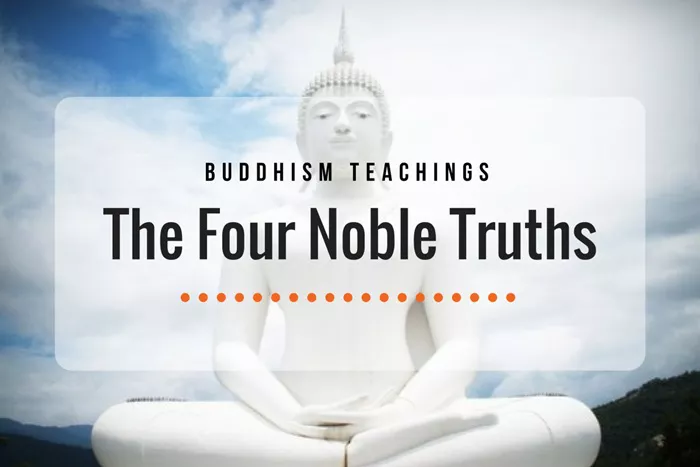The Four Noble Truths are the core teachings of Buddhism. They form the foundation of the Buddha’s path to enlightenment. These truths explain the nature of suffering and how to overcome it. Understanding them is essential for anyone who wants to follow the Buddhist way of life.
The four noble truths meaning is simple yet profound. They guide us to see the reality clearly and help us find peace.
The Origin of the Four Noble Truths
After the Buddha attained enlightenment under the Bodhi tree, he taught these truths for the first time in Deer Park, Sarnath. The truths were revealed as a way to understand the cause of suffering and the path to end it.
These teachings quickly became the heart of Buddhist practice. They are not just beliefs but practical steps to live by.
The First Noble Truth: The Truth of Suffering (Dukkha)
The first truth is about recognizing that suffering exists in life. This suffering is called dukkha in Pali, which means “unsatisfactoriness” or “pain.” It is the experience of pain, stress, and dissatisfaction that all beings face.
Suffering includes obvious things like illness, aging, death, loss, and sadness. But it also includes subtle forms like the anxiety of change or the feeling that life never fully satisfies us.
The Buddha taught that life in this world is naturally linked with dukkha. Even when we are happy, we worry about losing that happiness. This truth asks us to face suffering honestly.
Examples of Suffering
- Physical pain from injury or sickness
- Emotional pain such as grief or fear
- The discomfort of change and impermanence
- The frustration of unmet desires
The Second Noble Truth: The Cause of Suffering (Samudaya)
The second truth explains why suffering happens. It points to desire, craving, and attachment as the root causes. The word used is tanha, meaning thirst or craving.
People suffer because they want things to be different from how they are. This craving can be for material goods, pleasure, power, or even ideas and views.
Attachment leads to disappointment when things don’t last or go as expected. This desire traps beings in a cycle of wanting and dissatisfaction.
How Craving Causes Suffering
- Craving pleasure leads to fear of losing it.
- Attachment to self-image causes stress when challenged.
- Desire for permanence causes pain in an impermanent world.
The Third Noble Truth: The End of Suffering (Nirodha)
The third truth brings hope. It tells us that suffering can end. This state is called nirvana, which means the extinction of craving and suffering.
When craving ends, suffering also stops. This truth shows that freedom from pain is possible through the ending of attachments and desires.
This peace is not just temporary happiness but a deep, lasting liberation.
What Ending Suffering Means
- Letting go of selfish desires
- Realizing the true nature of self and life
- Living without fear of loss or change
The Fourth Noble Truth: The Path to End Suffering (Magga)
The fourth truth teaches the way to overcome suffering. It is the famous Eightfold Path. This path guides how to live wisely and ethically to reach enlightenment.
The Eightfold Path has eight parts, grouped into three categories: wisdom, ethical conduct, and mental discipline.
The Eightfold Path Explained
- Right View: Understanding the Four Noble Truths
- Right Intention: Having the right attitude and motivation
- Right Speech: Speaking truthfully and kindly
- Right Action: Behaving morally, avoiding harm
- Right Livelihood: Earning a living in an ethical way
- Right Effort: Cultivating good qualities and avoiding bad ones
- Right Mindfulness: Being aware of body, feelings, and mind
- Right Concentration: Developing deep meditation
Why the Four Noble Truths Matter Today
Even though the Four Noble Truths were taught over 2,500 years ago, they remain relevant now. They help people understand the cause of suffering in their lives and find practical ways to reduce it.
By learning these truths, we develop wisdom and compassion. We see life more clearly, without illusions.
Application in Daily Life
- Accepting that suffering is part of life helps us cope better.
- Recognizing desire helps us reduce greed and anger.
- Following the Eightfold Path improves our behavior and mental health.
The Four Noble Truths Symbol
The four noble truths symbol is often shown as a wheel with four spokes, representing each truth. This symbol reminds us of the Buddha’s teachings and the path to liberation.
The wheel, called the Dharmachakra, is one of the most important Buddhist symbols. It represents the cycle of life, suffering, death, and rebirth — and how the Four Noble Truths help break free from this cycle.
The Four Noble Truths in Different Buddhist Traditions
While all Buddhist schools accept the Four Noble Truths, they sometimes emphasize them differently.
Theravada Buddhism
Theravada tradition focuses strongly on the Four Noble Truths as the foundation of practice and meditation.
Mahayana Buddhism
Mahayana schools often integrate the Four Noble Truths with the teaching of compassion and the Bodhisattva path.
Vajrayana Buddhism
Vajrayana adds ritual and visualization but maintains the Four Noble Truths as central philosophy.
Conclusion
The Four Noble Truths are simple to understand but deep in meaning. They teach that suffering exists, has a cause, can end, and there is a path to end it.
Following these truths helps people live more peacefully and wisely. They are not just ideas but a practical guide to ending suffering and finding true happiness.

